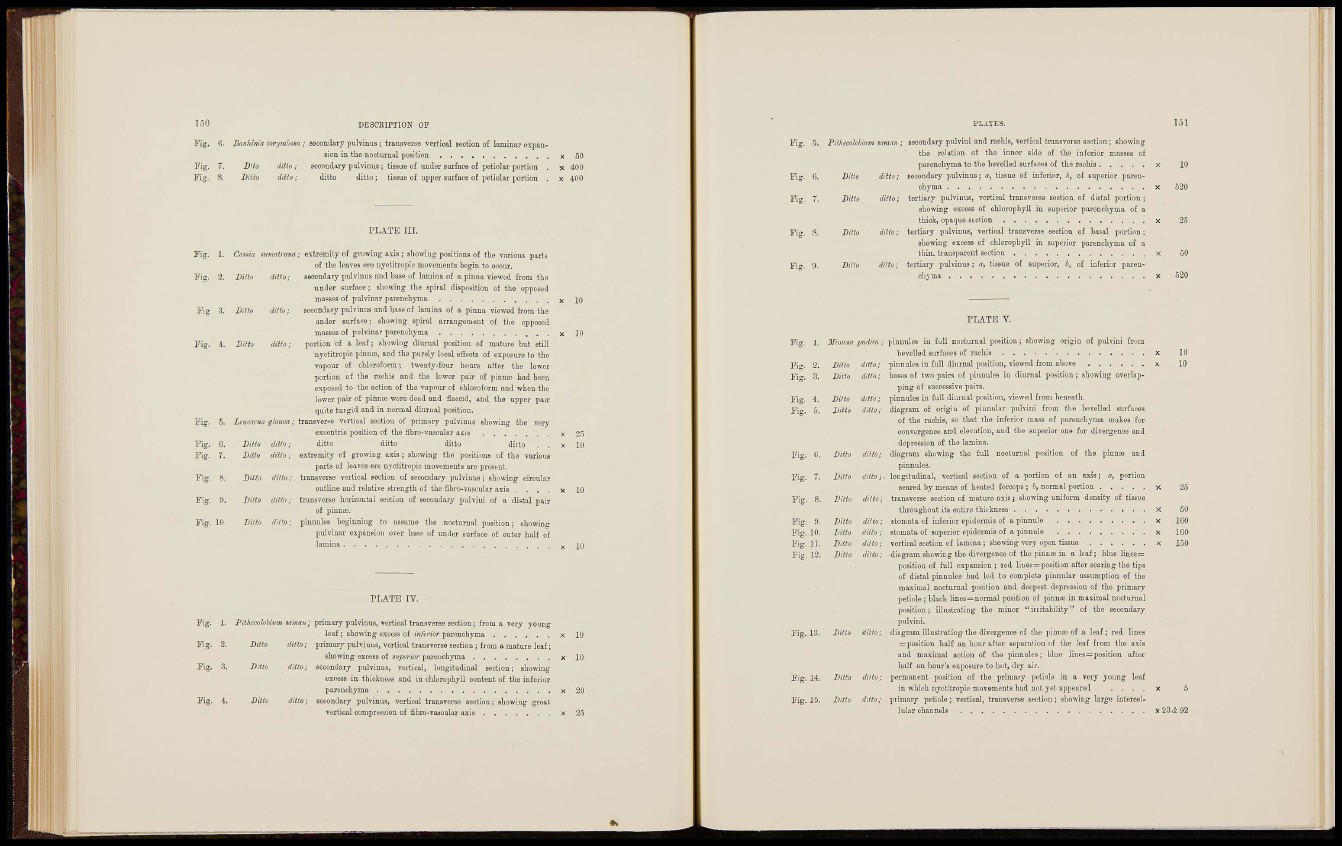
lòO DE5CEIPTI0N OF
Pig. 6. 7?««/iini"a corywioirt ; seooadory pulvinus ; trflDsvsrs© vGrticcil sootiOQ of Ifunis&r
sion in tlie nootuiaal position
Fig. 7. Dito diUo ; secondary pulvinns ; tissue of under surface of petiolar portion .
Fig. 8. Ditto ditto ; ditto ditto ; tissue of upper surfaoo of petiolar portion .
Fig. 1-
Fig. 2. Ditto ditto;
Fig 3. Ditto ditto;
Fig. 4. Ditio ditto;
Fig. 5.
Fig. 6. Ditto ditto ;
Fig. Ditto ditto ;
Fig. 8. Ditto ditto ;
Fig- 9. Ditto ditto ;
i-ig. 10. Ditto ditto ;
Fig. 1. Pit/iecolobium primary pulvinus, vertical transverse section; from a very young
Pig- 2. Ditto ditto; primary pulvinus, vertical transverse section ; from a mature leaf;
showing excess of auperior parenchyma
Fig. 3. Ditto ditto; secondary pulvinus, vertical, longitudinal section ; showing
esness in thickness and in chlorophyll content of the inferior
Fig. 4. Ditto ditto; secondary pulvinus, vertical transverse section; showing great
; 400
400
PLATE I I I.
Cnshia svmotvana; extremity of growing asis; sliowug positions o£ tlie farious parts
of the leaves ere nyctitropia movements begin to occur,
sedondary pulvinus aiid base of lamina of a pinna viewed from tbe
nnder surface; sliowing tlie spiral disposition of tlie opposed
masses of pulvinnr parenchyma
secondary pulvinus and base of lamina of a pinna viewed from the
under surface; showing spiral arrangement of tlie opposed
masses of pulvinar porenohyma
portion of a leaf ; showing diurnal position of mature but still
nyctitropic pinnso, and the purely local effects of exposure to the
vapour of chloroform; twenty-four hnurs after the lower
portion of the raohis and tbo lower pair of pinnto had been
exposed to tlio action of the vapour of cliloroform aod when the
lower pair of pinnco wore dead and flaccid, and the upper pair
quite turgid and in normal diurual position.
Leucnena gluuca ; transverse vertical section of primary pulvinus showing tbo very
escentric position of the fibro-vascular axis
ditto ditto ditto ditto . .
extremity of growing asis; showing the positions of the various
parts of leaves ere nyctitropic movements are present,
transverse vertical section of secondary pulviuns; showiog circular
outline and relative strength of the fibro-vascular axis . . . .
transverse horizontal section of secondary pulvini of a distal pair
of pinnte.
pinnules beginning to assume the noctumal position; showing
pulvinar expansion over base of under surface of outer half of
lamina
PL.V.Ti:S.
Fig. 5. Pithecololium mnm; secondary pulvini and raohis, vortical transverse section; showing
the relation of the inner side of the inferior masses of
parenchyma to the bevelled surfaces of the rachis
Fig- 6. Ditto ditto; secondary pulvinus; a, tissue of inferior, b, of superior parenchyma
Fig. 7. Ditto ditio; tertiary pulvinus, vertical transverse section of distal portion;
showing escess of chlorophyll in supeiior parenchyma of a
thick, opaque section
Fig. 8. Ditto ditto; tertiary pulvinus, vertical transverse section of basal portion;
. showing excess of chlorophyll in superior parenchyma of a
til in. transparent section
Fig. 9. Ditto ditto; tertiary pulvinus; a, tissue of superior, b, of inferior parenchyma
P I A T E Y.
Fig. I. Mimosa pudica ; pinnules in full nocturnal position; showing origin of pulvini frum
beveDed surfaces of rachis
pinnules in full diurnal position, viewed from above
aases of two pairs of pinnules in diurnal position ; showing overlapping
of successive pairs,
pinnules in full diui-nal position, viewed from beneath,
diagram of origin of piunulnr pulvini from tlie bevelled surfaces
of the raohis, so that the inferior mass of parenchyma makes for
convergence and elevation, and the superior one for divergence and
depression of the lamina.
Fig. 2.
Fig. 3.
Fig. 4.
Fig. 5.
Ditto ditto;
Ditto ditto;
Ditto ditta-;
Ditto ditto;
Fig. 6. Ditto ditto; diagram showing the full nocturnal position of the pinnto and
pinnules.
Fig. 7. Ditto ditto : . longitudinal, vertical section of a portion of an axis; a, portion
seared by means of heated forceps ; h, normal portion 25
Fig. 8. Ditto ditto; transverse section of matuie axis; showing uniform density of tissue
X 50
Fig. 9. Ditto ditto; X 160
Fig. 10. Ditto ditto ; X 160
Fig. 11. Ditto ditto; vertical section of lamina ; showing very open tissue X 150
Pig. 12. Ditio ditio ; diagram showing the divergence of the pinnoe in a leaf ; blue lines=
position of full expansion ; led lin es = position after searing the tips
of distal pinnules had led to complete piunular assumption of the
maximal nocturnal position and deepest depression of the primary
petiole ; black lines=normal position of pinnoe in maximal nocturnal
position; illustrating the minor "irritability" of the secondary
pulvini.
Pig. 13. Ditto ditto; diagram illustrafiiig the divergence of the pinnîc of a leaf; red lines
=position half an hour after separation of the leaf from the axis
and maximal action of the pinnules; blue lines=position after
half an hour's exposure to hot, dry air.
Fig, 14. Diito ditto; permanent position of the primary petiole in a very young leaf
in which nyctitropic movements had not yet appeared . . . . x 5
Fig. 15. Ditto ditto; primary petiole; vertical, transverse section; showing large intercellular
channels X 2 3 ^ 9 2